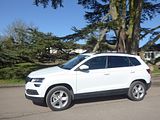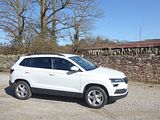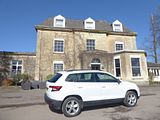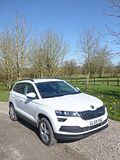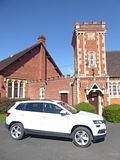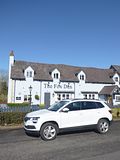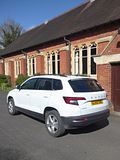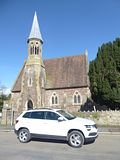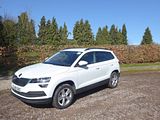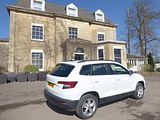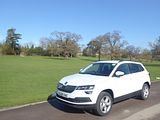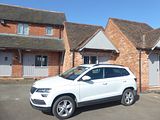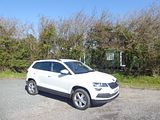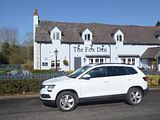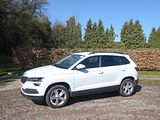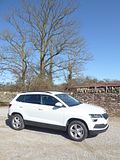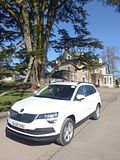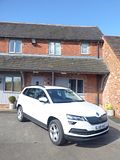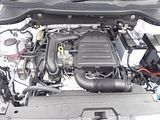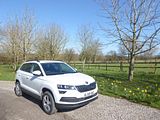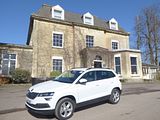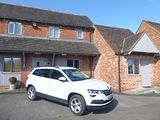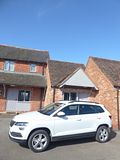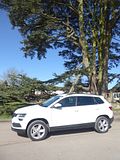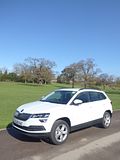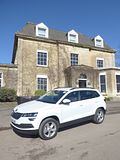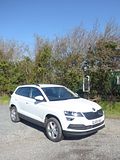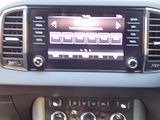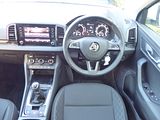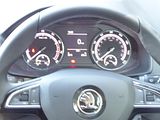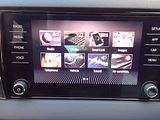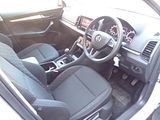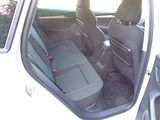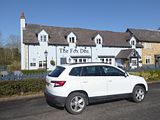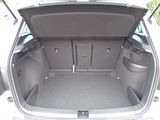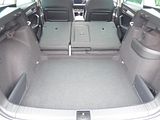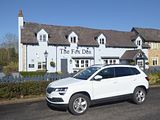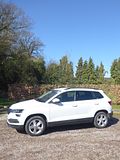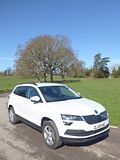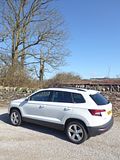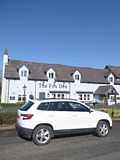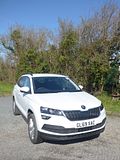There are plenty of examples where the replacement for a much-loved car failed to hit the spot even if in purely objective terms, the new product was “better” than the model it replaced. It must be something which worries manufacturers when they are conceiving their new model. Skoda definitely had this challenge following the huge enthusiasm that was generated by their Yeti. Whilst models like the Octavia and Fabia had done a huge amount to transform this long-standing Czech marque’s reputation with cars that scored on excellence and value for money in a way that the pre-VW era models had never got close to doing. But, good though they were, these were cars that people needed as opposed to cars they really wanted. The Yeti changed that, and as soon as it hit the market, and following very favourable press reviews, this small crossover quickly built up a massive waiting list for a new one, meaning that the few second hand ones held their value so well that for several years this was the car quoted as having the lowest depreciation of anything this side of a limited edition hypercar. But as every manufacturer knows, even a cult product like the Yeti cannot continue for ever and so a successor had to be developed, and the result was first seen in May 2017. The car adopted a new name, ending with the letter “q” to fit with Skoda’s naming strategy an also, so we were told, as a matter of respect to those in Asian markets who may have been troubled by the Yeti name. I suspect that secretly they worried about unfavourable comparisons between old and new. The Karoq was noticeably larger than the Yeti – a full 20cm – leaving space for another crossover in the range to sit below, which would eventually appear as the Kamiq, so the Karoq was now positioned very much as a C-segment crossover, a class that is full of alternatives ranging from the big-selling Kia Sportage, Hyundai Tucson and Nissan Qashqai, as well as an option from just about every other volume manufacturer. I was a huge fan of the Yeti, managing to drive a couple of them during its life, so was keen to see how the Karoq would measure up. My chance when Hertz at London Heathrow put my name on one of their cars which I would have for a whole week of the sort of driving I do, a lot of which was up and down the motorways of the country.
At launch, the Karoq was available with four engines, two petrol and two diesel, all of them familiar from other applications across the VW Group. The diesels are a 115bhp 1.6 litre TDi and a 150 bhp 2.0 litre unit, this latter available with optional AWD and the petrols are the 1.0 TSi 3 cylinder and the 150 bhp 1.5 Evo four cylinder unit. A more potent 190 bhp 2.0 TSi unit was added to the range in early 2019. The car I received featured the 1.0 TSi 3 cylinder engine which puts out 115 bhp. That might not seem that much for a car of this size, but actually, it did not seem to be wanting during my testing, admittedly one up and with minimal luggage on board. It is a refined engine and there is plenty of sound deadening in the Karoq which meant that this was a particularly quiet car once underway. Indeed, it was generally hard to tell that there was any engine there let alone one with 3 cylinders which usually means that there is a characteristic noise evident. The test car had the six speed manual gearbox. The gearchange is good with the lever slotting cleanly and with nice precision between the ratios. First is only really useful for getting going, but once you are in second or a higher ratio the available torque from low down the rev range meant that the Karoq had plenty of mid range acceleration. The trip computer reported an average between 43 and 47 mpg on each journey I undertook in the Karoq, and these days such devices tend to be quite accurate. I covered 600 miles in the week that I had the Karoq and it needed 62 litres to fill it, which computes to 43.93 mpg, assuming that I returned the car as full as it was when I collected it. That has to count as a decent result for a practical family car of this size. There is a stop/start system which would help if you were doing much in the way of urban motoring.
The Karoq is engineered more for comfort than fun as Skoda have concluded that this is probably what the majority of buyers would prioritise. The steering is very light and can feel a bit vague at times, which is a fairly common feature of cars in this class. It does mean that the car is easy to manoeuvre, but does rob it of the sense of fun that you get in a Ford Kuga or a Mazda CX-5. There is plenty of grip, but if you tackle the bendy roads with some gusto there is also plenty of understeer. Driven more normally, the Skoda will seem fine, and you will probably be grateful for the relatively soft suspension for the impressive ride comfort that the Karoq delivers. The test car came on 215/55 R17 wheels. The brakes did their job well, and I noted that the electronic handbrake disengages more readily than most such systems. There is generally good visibility, helped by some large door mirrors which are heated and fold in when parked up. I particularly appreciated the excellent headlights which were little short of amazing on both dipped and main beam. The Karoq has the latest safety features that are becoming ubiquitous if not always appreciated. The simple graphic suggesting you are too close to the car in front is easy to ignore and thankfully the lane departure warning system was easy to turn off.
Skoda may still be seen as the “budget” brand within the VW Group (it is a relative term, these days), but you’d be hard pressed to guess that when you look inside even in this version, an SE, which is the entry level trim. Looking very similar to what you will find in the brands Octavia and even the larger Kodiaq models, the Karoq has a neatly presented cabin which look and feels to be of high quality. There is a soft-touch feel to the dash, and although the door casings are harder, they still look decent enough. There is a leather wrapped wheel which was pleasant to hold though I did notice a harder edge to the lower rim. The dash is relatively simple by modern standards. There are two large dials for the speedometer and rev counter with smaller ones for fuel level and water temperature inset in their lower portions and a digital display in between them, all in a simple cluster. The dials are neat and easy to read. The Karoq uses plenty of parts from the corporate parts bin, though this is not that evident unless you are familiar with other VW Group products. There are twin column stalks for indicators and wipers, with an additional stubbier one for the cruise control. Lights operate from a rotary dial on the dash to the right of the wheel and there is an auto function. The Karoq uses a standard VW Group infotainment screen for audio and other functions which is mounted high in the dash. It proved easy to use. On the SE spec of the test car, you don’t get a lot of functions here, but the radio does include DAB. Below this are buttons for the dual zone climate control system. Overall, the impression is one of ease of use, which is not something you can say about the ever mode complex control systems for cars even in this class. One of the things that sets Skoda models apart from the competition is its ‘simply clever’ features. These are little touches that make life with a car that little bit easier, from an umbrella cleverly concealed under the passenger seat to a removable LED torch in the boot. Useful in the winter months is the ice scraper in the fuel filler cap, and there are plenty of minor but detailed touches like a holder for the 12v cigarette lighter if you’re using the socket to charge a phone. They’re all such simple things that it’s a surprise other manufacturers don’t do something similar.
This version of the Karoq has cloth upholstery and the seats are adjusted manually. This includes a lumbar support which is not something you will find on that many cars at this price. There are height adjustable seat belts and there steering wheel telescopes in/out and up/down, so getting a good driving position was easy. The crossover styling means that there is plenty of headroom, and indeed the Karoq does exude a feeling of space and the seat proved comfortable which was appreciated on longer journeys. There is plenty of space in rear, with ample legroom even when the front seats are set well back. The centre console unit doe come quite well back, and there is a noticeable central tunnel, so a middle seat passenger would need to straddle this. Headroom is particularly generous. Occupants here get a drop-down armrest and there are air vents which will be welcome. An unusual feature are picnic tables on the back of the front seats and there are also map pockets on the lower part of the seat backs and bins on the doors for odd and ends.
The boot is massive, larger, apparently than a BMW 5 Series Touring and it is a nice regular shape, with side compartments for odds and ends meaning the main load area is squared off. There are plenty of hooks to allow you to anchor smaller items of luggage. The rear seat backs have a ski flap in them and are asymmetrically split, folding to create a much larger load area. This can be made flat by using the false floor in the main boot area, thus creating a stowage space underneath. Under that there is also a bit of room for bits and pieces as there is no spare wheel to fill the well. Inside the cabin there is a small glovebox with a cooling function and as well as the door pockets which have a securing strap, there is a space in front of the gearlever, a central tray moulding for cups and coins, a cubby over the driver’s right knee and a recess on the dash top.
Skoda launched the Karoq in the UK with three different trims: SE, SE L and Edition. SE models feature 17-inch Ratikon alloy wheels, privacy glass, LED rear lights, integrated touch screen with DAB radaio and Bluetooth, dual-zone climate control, front assist, pedestrian monitor, and driver fatigue sensor as standard. SE L models add a host of additional features, including 18-inch Braga alloy wheels, Amundsen satellite navigation with 8-inch touchscreen display, Smartlink+, keyless entry and start/stop, full LED headlights with adaptive front light system, heated front seats, and Alcantara upholstery. Customers opting for the SE L also benefit from a colour multifunction trip computer, rear view camera and front and rear parking sensors as standard. Introduced to celebrate the launch of the all-new Karoq, the range-topping Edition trim offers customers the highest possible specification. All Edition models come with 19-inch Crater alloy wheels, panoramic sunroof, metallic paint and leather upholstery as standard. Columbus satellite navigation with 9.2-inch touchscreen display & gesture control, electrically operated boot and LED ambient lighting are also included in the standard specification, along with a host of safety and driver assistance systems. These include Lane assist, Blind spot protection with Rear traffic alert and Traffic sign recognition. A few months later, the SE Technology version joined the range. Aimed at business customers, it has Amundsen satellite navigation with an eight-inch touchscreen display with European mapping, voice control and integrated Wi-Fi. Drivers can connect to the infotainment system with ease thanks to Smartlink+ that pairs with Apple CarPlay and Android Auto and the Karoq also offers wireless charging and Phone Box Smartphone signal boost for improved communication on the move. Customers receive a one-year subscription to Infotainment Online that provides live traffic reports, calendar updates and online search functions. The touchscreen display also includes gesture control to make navigating the menus easier. Front and rear parking sensors, panoramic sunroof and LED daytime running lights come as standard on the SE Tech model, as well as adaptive cruise control. The SUV also includes the useful ŠKODA touches that customers have come to rely on, such as the ice scraper in the fuel cap, umbrella under the passenger seat, removable LED torch and handy storage compartments in the boot. The range grew again in August 2018 when the Karoq Scout model arrived. The Scout gets chrome and silver-coloured bodywork elements, anthracite 19-inch ‘Crater’ alloy wheels, tinted windows and Scout logos on the front mudguards. In the interior, the seats feature newly designed covers with black-brown contrasting seams. The multifunction leather steering wheel, pedals with stainless steel elements and an LED package that includes ambient lighting complete the extensive range of standard equipment. Further choice came with the Sportline version that arrived at the same time. It gets sports bumpers and the exclusive 19-inch ‘Vega’ black polished alloys wheels create a sporty appearance. The front mudguards bear the SportLine logo and the body colour and black entry area, tinted windows and black roof rails round off the model’s elegant exterior. The seats are upholstered with three-ply air-permeable Thermoflux fabric, which brings extra comfort to passengers, especially in summer. The multifunction sports steering wheel is covered with perforated black leather with stitching in silver. Pedals with stainless steel elements, a black headliner, black roof pillars and an LED package, which includes ambient lighting, complete the sporty interior.
The Karoq may not have the charm of its Yeti predecessor, but there is no denying the fact that this is a very capable and practical car which would perfectly meet the needs of a lot of people. Even in least powerful 1.0 petrol form, it goes well, it is economical, is decent to drive and very comfortable. There is plenty of space inside for people and luggage and the impression is of a nicely finished quality product that makes you wonder why you would pay extra for an Audi. So, an awful lot to like. It has lots of rivals, of course, and standards are such these days that picking between them all often comes down to personal choice rather than any one car being massively more competent than its rivals. That is probably where the ownership proposition comes in, and Skoda have built up an enviable reputation for customer satisfaction in recent years (higher than the rest of the VW Group), generally good reliability and whilst no longer the bargain price they used to be, also for value for money. By these criteria, the Karoq has to be considered one of the best propositions in its class, and probably deserving greater success than it has already achieved.


